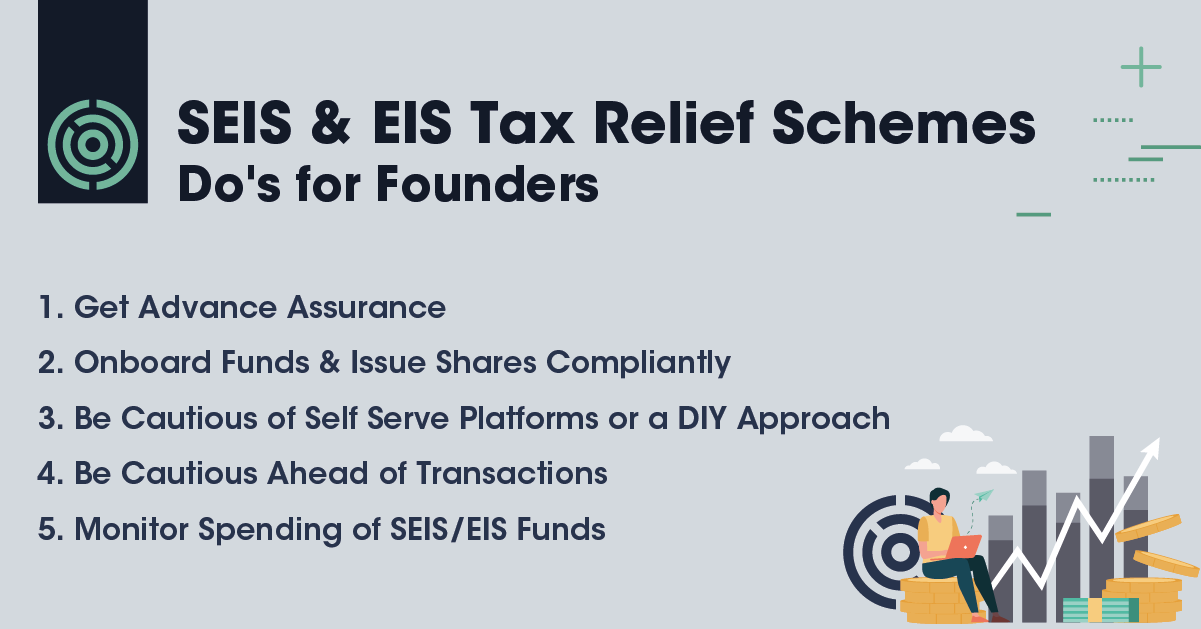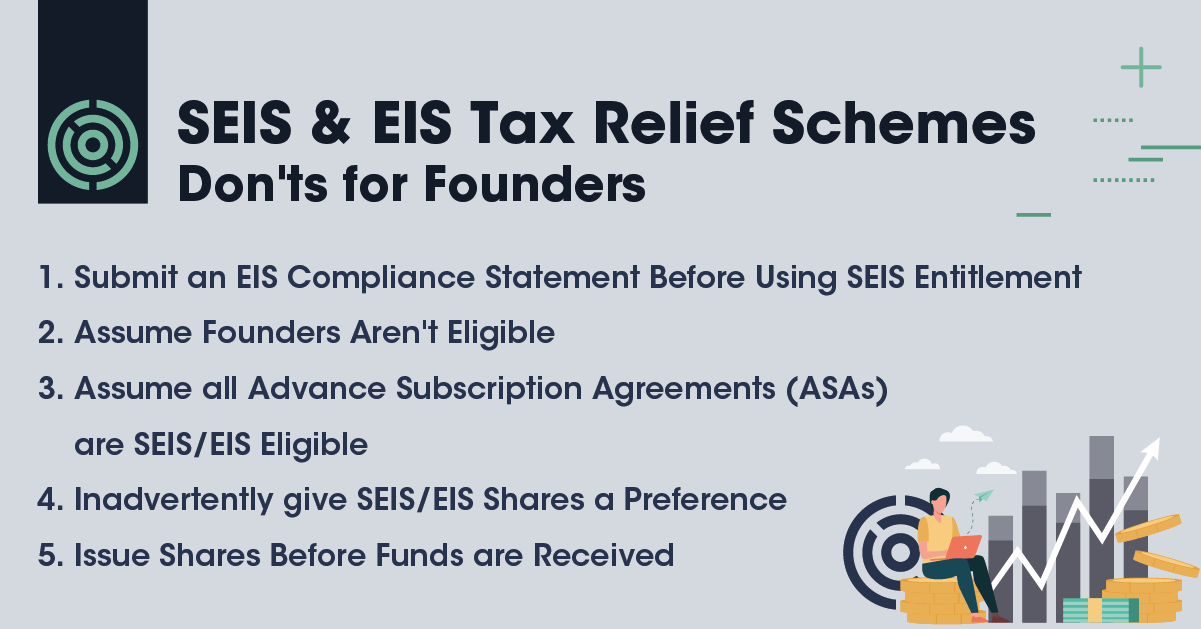SEIS and EIS Do's and Don'ts for Founders
Legal & Tax Support for SEIS and EIS Investment Schemes
In this article, Dragon Argent’s SEIS/EIS tax experts shared their top tips for founders and entrepreneurs when it comes to utilising the SEIS & EIS venture capital schemes. These are two of the four schemes managed by HMRC that enable early stage businesses that are potentially high risk to raise money from angel investors, crowdfunding platforms and venture capital trusts. They enable this by offering investors attractive capital gains tax breaks that significantly hedge the risk of their investments.
For any business looking to raise pre-seed to series A funding in the UK, offering SEIS & EIS relief to investors is almost a prerequisite for a successful raise. However, it is not always straight forward to navigate and we've seen numerous clients make mistakes in applying for seis/eis advance assurance over the years that can damage relationships with early investors and even invalidate their tax relief status. Hopefully our top tips below will help you avoid some of these pitfalls!
SEIS & EIS Tax Relief Schemes: Do’s For Founders
Get Advance Assurance: Advance Assurance is available in respect of both SEIS and EIS. As neither relief can be applied for until the investment in question has been made, submitting the relevant information to HRMC ahead of this allows the company to get an indication of whether HMRC agree that the investment (and the company) will qualify under the terms of either regime. This means that if there is any objection by HMRC as to eligibility this can be dealt with before any investment which otherwise may not qualify.
Having said that, the assurance itself is based on the information provided so the more specific and accurate an application for SEIS Advance Assurance or EIS Advance Assurance, the more reliable the indication from HMRC will be as a result.
Onboard Funds & Issue Shares Compliantly: Take in SEIS funds first and issue your SEIS shares at least a day before your EIS shares. Shares will not be SEIS eligible if they are issued on the same day as EIS shares. If you do issue both sets of shares on the same day then you would need to opt for EIS relief on all of them.
Be Cautious of Self Serve Platforms or a DIY Approach: Get advice prior and instruct professionals to submit your Advance Assurance and Compliance Statements. The SEIS and EIS requirements are complex and as mentioned above, not all mistakes can be rectified. The most common mistakes encountered on applications include:
Trying to apply for SEIS/EIS relief for an existing shareholder who holds non-SEIS/EIS shares – this cannot be done.
Applying for EIS too late. Subject to certain exemptions, EIS investment must take place within 7 years of the company’s first commercial sale.
Applying too early. Applications for SEIS/EIS can only be submitted once the company has traded for at least 4 months, or spent 70% of the funds raised. The “trading date” is not always the date of your first invoice so advice should be sought.
The company submitting the application doesn’t carry out a qualifying trade. Not all companies will be SEIS/EIS eligible. Certain trades such as banking, insurance and property based trade are ineligible. Licensing IP will also sometimes render the company ineligible and subsidiaries also need to be taken into account.
The investor for whom SEIS or EIS is being applied for and their associates together hold more than 30% of the ordinary share capital or voting rights in the company. If this 30% threshold is exceeded this will render the investor ineligible and companies often forget that associates are included in this calculation.
Value provided to the investor by the company hasn’t been declared. Where value is received by an investor, relief may be reduced or withdrawn. Care should be taken when confirming whether or not value has been received as transactions that you wouldn’t necessarily expect e.g. the company repaying a loan to an investor, may also count as value.
Be Cautious Ahead of Transactions: Take advice on SEIS/ EIS consequences before entering into any significant transaction. Some types of transaction can have adverse consequences on SEIS/EIS relief. Transactions to be particularly aware of include:
Share Buybacks. If a company buys back non-EIS shares from a non-EIS shareholder 12 months before or 3 months after an EIS share issue, there will be a clawback of EIS relief for the remaining EIS shareholders.
Grants. Certain grants and allowances that a company may be interested in may count as ‘de minimis state aid’. This is important to know from the outset as SEIS is also classed as ‘de minimis state aid’. This means that any additional ‘de minimis’ funding would need to be taken into account when determining whether the £250,000 SEIS maximum has been met.
Joint Ventures & Share for Share Exchanges. These types of transactions can cause companies to become ineligible in respect of SEIS/EIS due to requirements around percentage control over subsidiaries and qualifying trade.
Monitor Spending of SEIS/EIS Funds: There are requirements for each regime in relation to how long the company will have to use the funds raised. In addition, the funds can only be used for the purposes of the company’s trade. For many early stage start-ups it’s relatively easy to keep track of when and how funds are spent but once the company begins to make it’s own money the waters can be muddied unless you take a proactive approach to monitoring.
SEIS & EIS Tax Relief Schemes: Don’ts For Founders
Submit an EIS Compliance Statement Before Using SEIS Entitlement: Once an EIS compliance statement has been submitted to HMRC it cannot be withdrawn, even if it was submitted in error- so any SEIS relief would then be denied.
Assume Founders Aren't Eligible: Whilst it is true that the aim of the SEIS and EIS regimes is to encourage investment from third parties, this is not to say that founders can never be SEIS or EIS eligible. There are detailed rules which differ in respect of both regimes and set out the circumstances to apply to founders when deciding whether they are eligible. It’s important to take advice on this before incorporating the company and allotting founding shares.
Assume all Advance Subscription Agreements (ASAs) Are SEIS/EIS Eligible: The default position under the SEIS and EIS regimes is that investors will only be eligible for relief if they invest their funds in equity- not loans (even if they are convertible).The exception to this is that in some cases funds provided under ASAs may be eligible. HMRC guidance has been issued on when it is likely that an ASA will satisfy SEIS/EIS requirements and this includes:
When there is 6 month longstop date for shares to be issued;
Where the agreement is purely for equity;
Where there can be no variation or cancellation; and
Where there are no provisions in the ASA which would be standard for a loan document.
N.B. This is not definitive or conclusive guidance so checking the terms of any ASA with a professional is a must.
Inadvertently give SEIS/EIS Shares a Preference: As SEIS/EIS shares must be ordinary, full-risk shares this means that they must not carry any rights to preferential treatment. For example, a liquidation preference or preferential treatment over dividends. Some companies don’t realise that these rights can be inadvertently afforded to ordinary shares when articles of association or a shareholders’ agreement are drafted, particularly when a new class of shares is introduced which are to have lesser rights than the ordinary shares e.g. deferred shares. For this reason, both the articles and shareholders’ agreement should be carefully drafted, ideally by a professional with SEIS/EIS experience.
Issue Shares Before Funds are Received: In order to qualify under SEIS/EIS the shares issued must be ordinary shares which are subscribed for in cash and fully paid at the time of issue.
SEIS vs EIS QUALIFYING CONDITIONS
Seed Enterprise Investment Scheme
SEIS targets investment for early-stage companies:
Period from first commercial sale to investment - <3 years
Maximum number of staff - <25
Maximum inward investment eligible - £250,000
Company maximum gross assets when shares issued - <£350,000
Tax relief on investment for the investor - Can claim 50% of investment made
Tax relief for the investor on any losses made - Yes, at highest rate tax paid for net investment
Enterprise Investment Scheme
EIS supports larger and more established businesses:
Period from first commercial sale to investment - <7 years
Maximum number of staff - <250
Maximum inward investment eligible - £5,000,000 (tax period) and £12,000,000 (company life time)
Company maximum gross assets when shares issued - <£15,000,000
Tax relief on investment for the investor - Can claim 30% of investment made
Tax relief for the investor on any losses made - Yes, at highest rate tax paid for net investment
Apply for SEIS/EIS Scheme today
If you would like to discuss utilising either the SEIS or EIS schemes or to apply for SEIS or EIS Advance Assurance on an upcoming funding round for your business, contact Dragon Argent today to discuss eligibility and how to best manage the transaction. Schedule a discovery call with one of our tax advisors today.
For more SEIS/EIS guide Click Here>
Categories
- (S)EIS Tax Relief
- Accountancy Best Practice
- Art and Luxury Assets
- Business Immigration
- Commercial Law
- Commercial Litigation
- Corporate Law
- Corporate Strategy
- EMI Share Option Scheme
- ESG Compliance
- Employment Law
- Fundraising Strategy
- Human Resources
- Inheritance tax
- Intellectual Property
- Merger and Acquisition
- NFTs and Digital Trading
- R&D Tax Credits
- Startups & SME Advice
- Tax Advice
- UK Subsidiary







